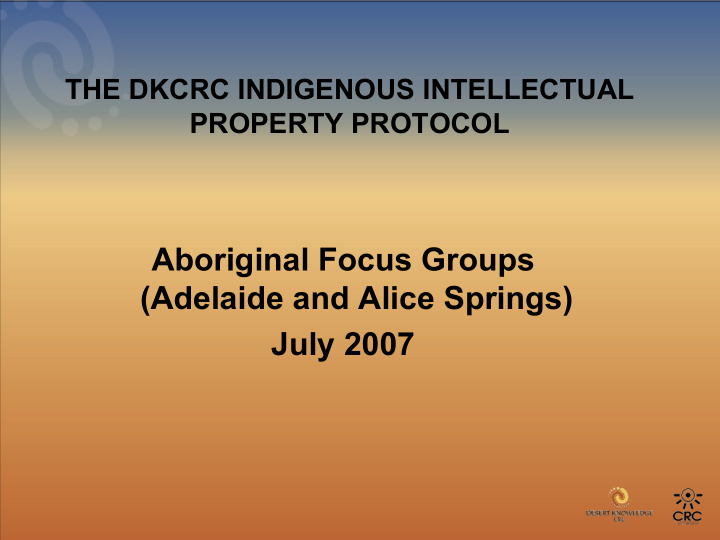



THE DKCRC INDIGENOUS INTELLECTUAL PROPERTY PROTOCOL Aboriginal Focus Groups (Adelaide and Alice Springs) July 2007
ABORIGINAL KNOWLEDGE AND INTELLECTUAL PROPERTY Two different systems Protocol DKCRC Western law Aboriginal knowledge
WHAT IS A PROTOCOL ? A Protocol is: • A set of rules; • A guide to how people should behave, • A tool for how to manage the research process and the products of research, • A document that can have some legal force.
ACHIEVING BALANCE • The DK-CRC Indigenous Intellectual Property Protocol aims to: – Protect Aboriginal peoples’ rights and interests in their culture and heritage, – Provide good, ethical standards in research engagement and practice, – Allow opportunities for negotiating commercial outcomes and benefit-sharing, and – Encourage proper management of IP
WHERE THE DK-CRC PROTOCOL FITS IN • It is part of a set of tools being developed by the DK-CRC to establish best practice in its research engagement; • It forms part of the DK-CRC Centre Agreement • It should be used with: – The Research Engagement Protocol – Prior Informed Consent Procedures
THE BIGGER PICTURE • The IIPP aims to establish best practice consistent with international and other standards. • Examples of international standards: – CBD & Guidelines and Statements – International Society of Ethnobiology Code of Ethics – Draft Declaration on the Rights of Indigenous Peoples – ILO Convention 169
THE BIGGER PICTURE (2) • Some Australian standards – AIATSIS Guidelines for Ethical Research in Indigenous Studies – NH & MRC Ethics – Guidelines for Indigenous Participation in Natural Resource Management
DEVELOPING ABORIGINAL STATEMENTS AND STANDARDS • UN Draft Declaration on Indigenous Peoples Rights • Mataatua Declaration (NZ/Aetoroa)
IMPROVING THE PROTOCOL • Are you happy with the title? • Suggestion: Protocol for Aboriginal Knowledge and Intellectual Property
ABORIGINAL KNOWLEDGE AND INTELLECTUAL PROPERTY • How are these things connected in the Protocol? • Should they be better described and/or defined? Are there better words that can be used? • Should the Protocol include statements about Aboriginal peoples’ rights to define their knowledge? • How can this be done?
WHAT IS THE PROTOCOL FOR ? • Is the Purpose properly set out? • Does it reflect your needs & interests? • How can it be improved? • Does it achieve its Philosophy (‘equitable partnerships’)?
THE PRACTICES • What practices should be included? Are the ones in there strong enough? How might they be improved? • The Protocol has the following: – Ethics (1) – Free, Prior Informed Consent (2) – Collection of Indigenous IP (3) – Use and Storage of Information (4)
PRACTICES (2) – Confidentiality (5) – Commercialisation (FPIC – 6) – Commercial Benefits (7) – Continual Improvement (8)
BENEFIT-SHARING • An important part of the Protocol is to make sure all participants in research share properly in benefits. • Does the Protocol set out how this will work in ways that you are happy with?
SHOULD THERE BE OTHER THINGS IN THE PROTOCOL? • Implementation strategies • Penalties • Monitoring and reporting • Awareness and information • List of definitions • Should there be a separate Plain Language Guide?
HOW DOES THE PROTOCOL WORK? • Relationship with DK-CRC Research Engagement Protocol • Relationship with Prior Informed Consent process • Relationship with DK-CRC Agreement? • Acts as a guide for researchers
ARE THERE OTHER DOCUMENTS NEEDED AS WELL? • Aboriginal Cultural Knowledge Protocol • How would this kind of Protocol work? • What things could be in this? • Examples: – Recognition of collective rights and interests – Recognition of customary laws – Links to spirituality, land, heritage, identity
Recommend
More recommend